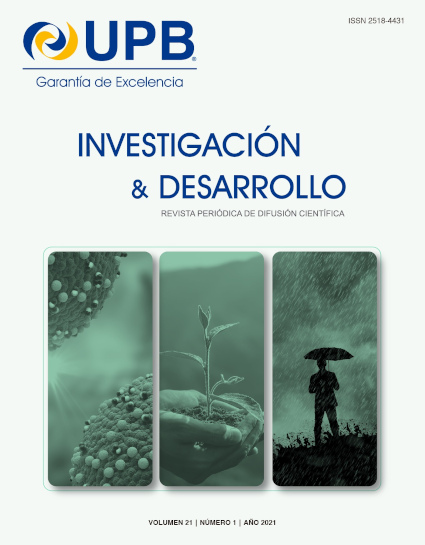ANALYSIS OF RESILIENCE IN INVESTMENT OF AN IRRIGATION SYSTEM BASED ON THE COMPARISON OF CLIMATE SCENARIOS
DOI:
https://doi.org/10.23881/idupbo.021.1-4iKeywords:
Climate Change, Analysis of Resilience in Investment (ARI), Mitigation, Resilience, Representative Concentration Pathway (CPR), Climate Models, Irrigation SystemAbstract
This document shows the Investment Resilience Analysis (ARI) of an irrigation system in the Cauchi Titiri Community, according to the comparison of climate scenarios (CCSM4 and MIROC). Also, the variability of the temperature and precipitation considering the scenarios of representative concentration trajectories (RCP): 2.6 _2020; 4.5_2050 and 8.5_2050. This area frequently suffers from floods, droughts, frosts and hailstorms. It is located in a semi-arid area, in which there is a medium level of threat in terms of droughts. Therefore, this area has a high water déficit. So, the implementation of an irrigation system is required to improve the yield of agricultural production and guarantees the availability of water for irrigation in the area. The results obtained from this analysis indicate that there is an increased threat of droughts and frosts, which were considered as main risks for the ARI. According to the corresponding analysis, which is based on three study modules, Risk Analysis, Climate Resilience Analysis and Benefit / Cost Analysis, risk exposure mitigation measures were proposed, such as changing the location of the reservoir and strengthen not only the cleaning capacities of the irrigation system, but also the capacity to deal with climate change events. Consequently, as a result of the implementation of these measures, a 40% reduction in the risk of the system will be achieved, considering the current risk and the risk of climate change. For its part, an avoided cost of Bs. 1,526,668 will be reached due to reconstruction losses and attention to the emergency.Downloads
References
Gobierno Autónomo Municipal de Patacamaya - Tiburcio Choque, «Plan Territorial de Desarrollo Integral del Municipio de Patacamaya (2016 - 2020),» La Paz, 2016 .
A. A. Mamani Huanca, «Repositorio Institucional - Universidad Mayor de San Andres,» 2016. [En línea]. Available: https://repositorio.umsa.bo/handle/123456789/6807. [Último acceso: 23 febrero 2021].
M. L. Zurita, «Analisis de Resiliencia en Inversiones (ARI) - Guía para la toma de decisiones en proyectos de infrestructura resiliente con enfoque de reducción del riesgo de desastres y adaptación al cambio climático,» Teleioo SRL, La Paz, 2018.
Panel Intergubernamental de Expertos sobre el Cambio Climático, «Sintesis Resumen para Responsables de Políticas,» 2014.
Universidad de Nebraska-Linconln con el apoyo del Banco Interamericano de Desarrollo, «Portal Regional de Datos sobre Cambio Climático Consorcio de América Latina y el Caribe,» 13 diciembre 2017. [En línea]. Available: http://rccdp.unl.edu/portal/. [Último acceso: 20 marzo 2021].
C. M. Rowe, «Portal Regional de Datos sobre Cambio Climático Consorcio de America Latina y el Caribe,» 13 diciembre 2017. [En línea]. Available: http://rccdp.unl.edu/portal/. [Último acceso: 18 marzo 2021].
A. W. Burgoa Mariaca, «Escenarios de Cambio Climático en el Sur del Departamento de La Paz: Patacamaya y Calacoto,» Revista Boliviana de Física, nº 17, pp. 35 - 40, 2010.
SENAMHI, «Base de datos Sistema Meteorológico (SISMET),» 2016. [En línea]. Available: http://senamhi.gob.bo/index.php/sismet [Último acceso: 3 Abril 2021]
F. Cuenca, Interviewee, Secretaria Municipal Técnica del Gobierno Municipal de Patacamaya. [Entrevista]. 17 marzo 2021.
E. Apaza, Interviewee, Técnico Veterinario - Unidad de Gestión de Riesgos del Gobierno Municipal de Patacamaya. [Entrevista]. 17 marzo 2021.
C. d. l. C. C. T. d. M. d. Patacamaya, Interviewee, [Entrevista]. 17 marzo 2021.
C. Canedo y M. García, «Evaluación del requerimiento de agua en zonas productoras de quinua bajo condiciones de cambio climático,» Revista de Investigación e Innovación Agropecuaria y de Recursos Naturales, vol. 2, nº 1, pp. 7 - 118, 2015.
E. Conde Viscarra, «Repositorio Institucional - Universidad Mayor de San Andres,» 2016. [En línea]. Available: https://repositorio.umsa.bo/handle/123456789/6807. [Último acceso: 25 febrero 2021].
M. X. Calderón Sanchez , «Mapeo de vulnerabilidad climática actual y futura en base al análisis de los factores de exposición, sensibilidad y capacidad adaptativa en el Espacio Natural de Conservación Hampaturi,» La Paz, 2019.
W. García, M. Delfin y M. Azero, «Escenarios de cambio climático y sistematización de tecnologías campesinas e innovaciones tecnologías contra las heladas,» ACTA NOVA, vol. 8, nº 2, 2017.
HELVETAS Swiss Intercooperation, Analisis de Resiliencia en Inversiones (ARI). La Paz, 2018.
Downloads
Additional Files
Published
Issue
Section
License

This work is licensed under a Creative Commons Attribution-NonCommercial-ShareAlike 4.0 International License.
Creative Commons Attribution-Noncommercial-Share Alike
CC BY-NC-SA
This license lets others remix, tweak, and build upon your work for non-commercial purposes, as long as they credit the author(s) and license their new creations under the identical terms.
The authors can enter additional separate contract agreements for non-exclusive distribution of the version of the article published in the magazine (for instance, they may publish it in an institutional repository or a book), subject to an acknowledgement of its initial publication in this magazine.
